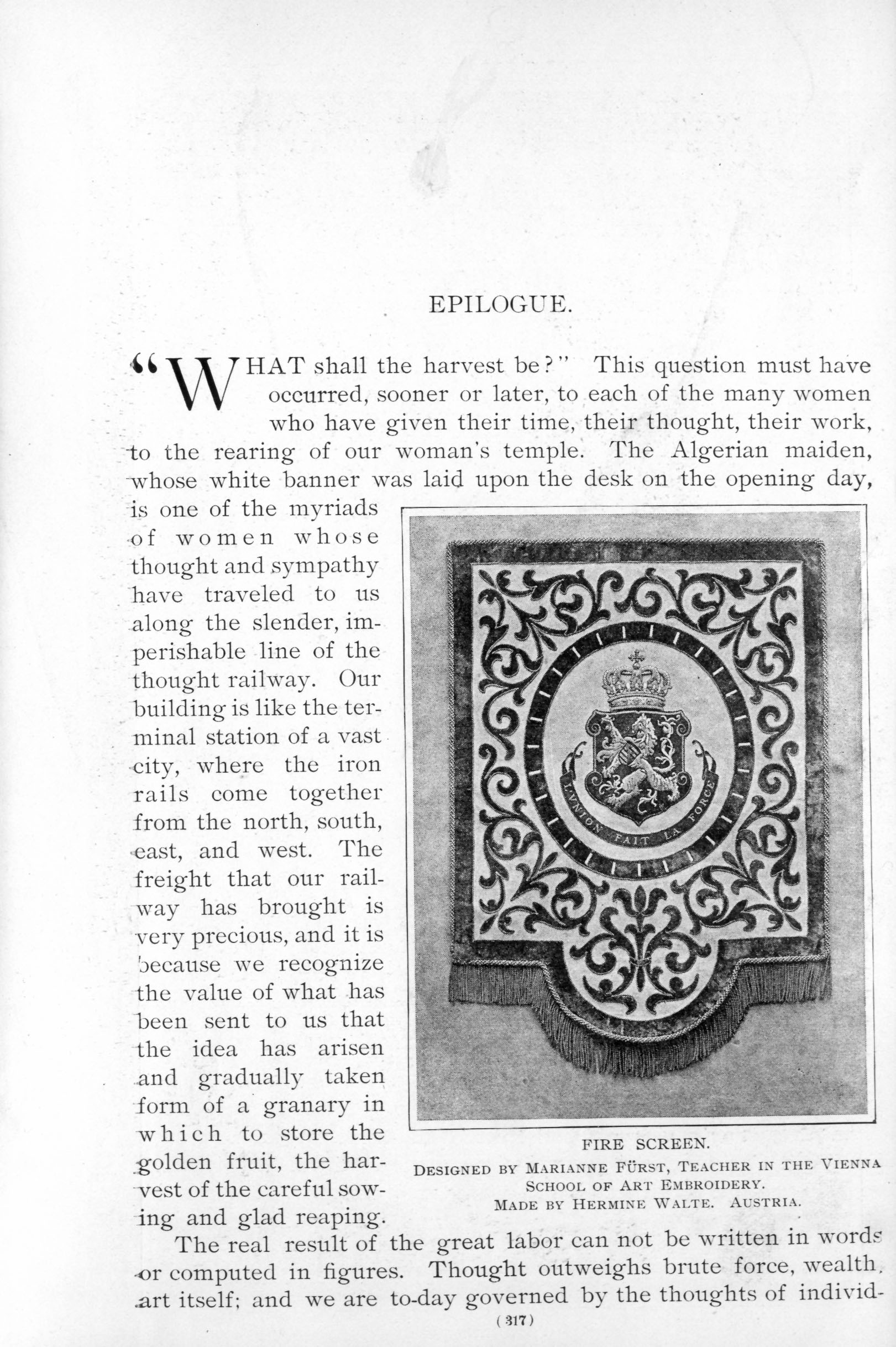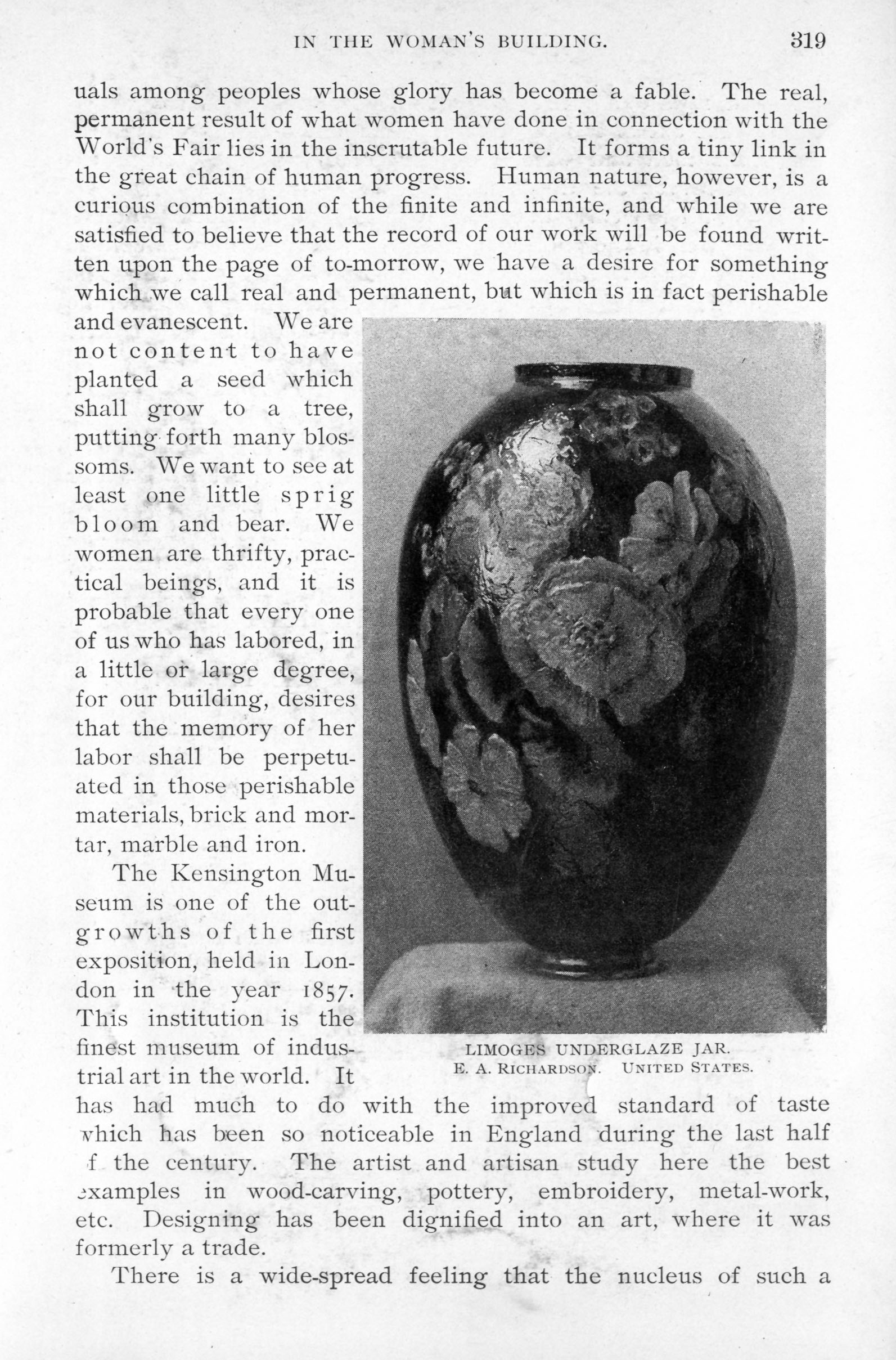
FIRE SCREEN.
DESIGNED BY MARIANNE FÜRST, TEACHER IN THE VIENNA
SCHOOL OF ART EMBROIDERY.
MADE BY HERMINE WALTE. AUSTRIA.
EPILOGUE.
"WHAT shall the harvest be?" This question must have occurred, sooner or later, to each of the many women who have given their time, their thought, their work, to the rearing of our woman's temple. The Algerian maiden, whose white banner was laid upon the desk on the opening day, is one of the myriads of women whose thought and sympathy have traveled to us along the slender, imperishable line of the thought railway. Our building is like the terminal station of a vast city, where the iron rails come together from the north, south, east, and west. The freight that our railway has brought is very precious, and it is because we recognize the value of what has been sent to us that the idea has arisen and gradually taken form of a granary in which to store the golden fruit, the harvest of the careful sowing and glad reaping.
The real result of the great labor can not be written in words or computed in figures. Thought outweighs brute force, wealth, art itself; and we are to-day governed by the thoughts of individ-

SCREEN.
PAINTED AND EXHIBITED BY H. I. H. THE ARCHDUCHESS MARIE THERESE.
AUSTRIA.

LIMOGES UNDERGLAZE JAR.
E. A. RICHARDSON.
UNITED STATES.
uals among peoples whose glory has become a fable. The real, permanent result of what women have done in connection with the World's Fair lies in the inscrutable future. It forms a tiny link in the great chain of human progress. Human nature, however, is a curious combination of the finite and infinite, and while we are satisfied to believe that the record of our work will be found written upon the page of to-morrow, we have a desire for something which we call real and permanent, but which is in fact perishable and evanescent. We are not content to have planted a seed which shall grow to a tree, putting forth many blossoms. We want to see at least one little sprig bloom and bear. We women are thrifty, practical beings, and it is probable that every one of us who has labored, in a little or large degree, for our building, desires that the memory of her labor shall be perpetuated in those perishable materials, brick and mortar, marble and iron.
The Kensington Museum is one of the outgrowths of the first exposition, held in London in the year 1857. This institution is the finest museum of industrial art in the world. It has had much to do with the improved standard of taste which has been so noticeable in England during the last half of the century. The artist and artisan study here the best examples in wood-carving, pottery, embroidery, metal-work, etc. Designing has been dignified into an art, where it was formerly a trade.
There is a wide-spread feeling that the nucleus of such a

museum now exists in the Woman's Building, and a growing desire that out of it may grow a permanent building which may serve the men and women of our country as the Kensington Museum serves the English.
It is still too early to speak definitely of this idea which is shaping itself in the public mind, but there are many who believe that the Woman's Building is the corner-stone of a new and splendid edifice; if it has been laid true, and firm, and square, the hundreds of women who have labored for it will feel that their efforts are well repaid.
In the Government Building one of the most valuable exhibits is a collection of coins of all nations and ages. It contains beautiful Greek and Roman coins, and picturesque oriental pieces of money; but in all the rich display there is not one bit of gold or silver that interests us as profoundly as the tiny bit of metal known as the "Widow's Mite." If every woman who has learned something or enjoyed somewhat through the means of the building will contribute her mite, the thank-offering will raise and equip the permanent building in a manner worthy of the cause to which it will be devoted.
THE EDITOR.
The limits of this volume have made it impossible to mention anything outside of the Woman's Building, and, owing to unavoidable delays, much that is valuable and interesting in the building itself was made ready at too late a day to receive mention here; thus New York's fine "Loan Collection" in the Woman's Building, while arranged at an early day, was classified at too late a day to receive the mention it deserves in our book.
Attention is called to the colonial loan collections of the thirteen original States, made under the direction of the Board of Lady Managers, in the rotunda of the Government Building. These contain articles of priceless value and interest.
In the northeast corner of the gallery in the Liberal Arts Building a space is devoted to woman's work. Here may be seen a stained glass memorial window by Mary Tillinghast, very beautiful in color and tender in sentiment. Miss C. E. Scott exhibits a collection of china and embroidery which should be visited by all persons who are interested in these branches of decorative art. Annie Leota Way exhibits some clever designs, and a well-constructed relief map of Palestine, and Ella Cogswell Ripley shows some excellent designs for wall papers. These are but a few of the interesting features of this department. This section of the Liberal Arts Building is under the direction of Mrs. Rosine Ryan.—ED.